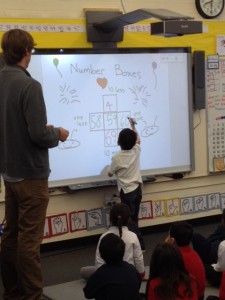Screen Time for Yew Chung International Students
By Martha Sessums
It started early. At 8:15 a.m. to be exact. Mr. Wheatly’s kindergarten class at Yew Chung International School, in Mountain View, sat on the floor and looked at the Smartboard screen. They were totally engaged as they reviewed out loud the months of the year, days of the week and their order (the students claimed Friday was Mr. Wheatly’s favorite day), dates of the month, even the number of days school had been in session. (I visited on the 59th day of school.)
They became creative about sentences and raised their hands with ideas for the ending of the sentence, “A rainbow is . . .” A colorful rainbow on the screen waited for Mr. Wheatly’s favorite suggestion. He wrote: “. . . so popular.”
Then they turned to numbers, and the students took the school day number (59) and volunteered to write on the screen the number that is one less, one more, ten less and ten more. They decided if it is odd, even, its place value of hundreds, tens and ones and how to write 59 using letters. They even discussed and decided on the day’s weather.
All done on a screen.
Mrs. Hanson allowed her 5th graders to hand write their essays, but input the final draft on a computer. A cart of electronic equipment was stationed near the front of the room with many empty slots as the computers sat on desktops with students tapping away. The kids then moved to the group section of the room to use their Smartboard to learn about tsunamis from Brainpop’s animated educational program. Storytellers used visual drawings of wave action after earthquakes, explaining why tsunamis are so dangerous and unpredictable. (The strong water force is underwater.) There was a pop quiz where each student answered a question. All answered correctly. Showoffs. On a screen. Double showoffs.
The technical wizard of the Yew Chung International teaching staff is Mr. Cobbs. His 4th grade class was using iPads to write and illustrate their original stories. Using their fingers as a paintbrush, teams of students drew colorful stick characters, animals, trees, grass huts or whatever was needed to illustrate their tale. Like graphic novels, the action was illustrated as they developed character, plot, story arc and endings. On a screen.
That evening I had dinner with a good friend who said that she was concerned about controlling the amount of screen time exposure for her young kids. She meant television, but also time with the iPhone playing games. I asked if her kids had Smartboards in their school. Oh, yes. In fact, each child participates in daily role call by moving its name into the “Here” column on the screen, plus learning experiences like those at Yew Chung International.
Welcome to modern screens. They will be everywhere, a natural part of the landscape and a tool assisting creativity and learning. Sure, the challenge is to keep the quality of the screen time high, and there will be junk, the stuff my friend is worried about. But with so much positive exposure to screens, using them frequently becomes a teaching moment itself for what is good on a screen. Perhaps Mr. Wheatly’s kindergarteners will choose better content throughout their lives if their daylong experience with screens at Yew Chung International is focused on learning and creating.



